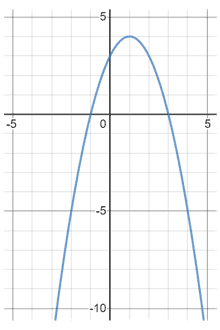Quadratic function
A quadratic is a polynomial where the term with the highest power has a degree of 2.
The parent function of quadratics is:
f(x) = x2
Quadratic functions follow the standard form:
f(x) = ax2 + bx + c
If ax2 is not present, the function will be linear and not quadratic. Quadratic functions make a parabolic U-shape on a graph. If a is negative, the parabola is flipped upside down.
Example
f(x) = -x2 + 2x + 3

Quadratic functions are symmetric about a vertical axis of symmetry. This axis of symmetry can be calculated using the formula:
x =
The vertex is the point found on the axis of symmetry. Because you know the x coordinate of the vertex from the axis of symmetry, you can plug that value into the function to find the y-coordinate.
Example
|

|
The quadratic equation is an equation where you set the quadratic function equal to 0. Solving the quadratic equation yields the zeroes, or solutions, of the quadratic.
ax2 + bx + c = 0
